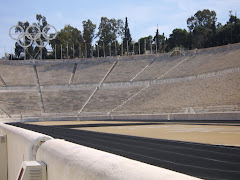Not long ago -- before the awful Oklahoma tornado news, a 40th birthday vacation in New Mexico, and a week of work at Cedar Point theme park in Sandusky, Ohio (all experiences about which I will eventually write) -- an online calendar listing caught my eye in April.
The brief mentioned the
Atlanta Contemporary Art Center just opened a photography exhibition titled "
The Olympic City" featuring numerous works compiled by a pair of photographers who visited several five-ringed host cities. The exhibition continues through June 15.
Though I regret the travel-related delays to craft this post (it's been a few weeks since a rainy afternoon visit to the exhibition), it's been good to reflect on the show in anticipation of a
panel discussion set for March 23 (Thursday night -- tomorrow at 6:30 p.m.) and an upcoming
Atlanta Olympic field trip also planned by the museum on June 8.
"The Olympic City" features several dozen images created by photographer Jon Pack and filmmaker
Gary Hustwit, who since 2008 trekked the globe to explore past Olympic host cities and evidence of impact and legacy from the big event. Details of their journey are chronicled via
The Olympic Project.
Not every Olympic host city is represented, but the exhibition includes a healthy mix of recent and older, summer and winter, historic and less iconic Olympic developments. Most Olympiads from Rome 1960 to London 2012 are covered, with Munich as the only gaping hole in Hustwit's and Pack's travels.
I pondered the exclusion of Munich and the extent to which this may be intentional since the 1972 Games, in many ways, defies one component of the exhibition, presented to serve as a "possible guide to the dos and don’ts of contemporary built environments." If not overshadowed by the events of Sept. 5, Munich's Games would stand today as a marvel of Olympic legacies done right.
"The Olympic City" exhibition skews on the "don'ts" in many ways. Why include Berlin 1936 without the Bavarian Olympic counterpart of 1972? If you want to make an anti-Games point, leaving out Munich is one way to punctuate the point.
Seoul's 1988 successes also are excluded; but then, maybe Korea remains on the photographers' "to do" lists, not yet earning enough votes from those tallied by project donors.
Most of the exhibition photographs provide a beautiful and thoughtful snapshot on the many ways time buffs away the shimmer of the Olympic glory days. Images of Barcelona's amazing 1992 architecture and Mediterranean-nestled venues stand out. A look at inner-city Los Angeles and remnants of 1932 and 1984 influences are interesting and shed new light on lesser-known legacy projects (In 2003, I
think I bought ice cream from the same vendor photographed at the L.A. Coliseum).
A peek at small town Lake Placid, N.Y., brought back memories of my own visit to the Olympic Village in the Adirondacks and the conversion of housing to modern prison. And a look at the harsh realities of war torn Sarajevo allude to the dark tale of the region's post-Games horrors. Well done.
So it confused me that when their project visited Mexico City, Pack and Hustwit missed some spectacular and positive impacts of the Games. Where was their photo of Diego Rivera's murals created for the Olympic venues? Not here, perhaps overlooked on the hunt for homeless inhabitants of a city long-since changed by the Olympic impact, or missed while exploring the crapped out Olympic Village cinema?
In London, why show the trash-strewn backside of an Underground station when across town there are new world class buildings by renowned best-of-our era architects (like in Barcelona)? I liked the Banksy-style anti-Games spray paint commentary (and concur, not everyone likes the Olympics). But there was a lot of graffiti photographed in this exhibition, across many Olympic cities, where more attention could have gone to non-negatives and non-alleyways. I had the feeling both photographers got locked on a mission to find the filth.
There are exceptions. On the luxury side, I liked the Helsinki image of an historic waterfront hotel opened in 1952. Images of the people in or around the once-Games gathering places are more personal and thought provoking -- what was the personal legacy for these individuals, I wondered. The bandage-clad Montreal Olympic Stadium also stood out for this visitor.
But the exhibition kept bringing me back to
observations of other art museum photography noted earlier this year. Why go for decrepitude when there is more positive "out there" to be captured by the lens?
One other Olympic city stood out for its exclusion from the current exhibition stop: Atlanta and the 1996 Games. I'd like to think that the museum's planned June 8 "opinionated tour" will be fair and balanced, including Atlanta's "good" Olympic legacy elements (Centennial Olympic Park, 7,000+ college dorm rooms, Georgia Tech Aquatic Center, Turner Field, Atlanta History Center archives and expansion) and forgotten legacies (tennis center, AUC venues), but have a sinking feeling the tour may be a Fox News version of "fair" and "balanced" skewed on the negative side. Thursday night's
panel discussion should be interesting to experience.
Other critics and reporters offered their POV on the exhibition when it stopped
in Atlanta and
recent markets. The
book version of the exhibition is coming soon, too.
Should anyone go see "The Olympic City" exhibition? Yes, absolutely! Just soak it in with a grain of salt, looking beyond the grime to the brighter side of the cities once lit by the Olympic flame.
Photos of exhibition by Nicholas Wolaver include works copyrighted by Jon Pack and Gary Hustwit -- view their gallery here. The Montreal stadium image at the top of this post is from the exhibition and its website OlympicCityProject.com

.jpg)
.jpg)
.jpg)


















